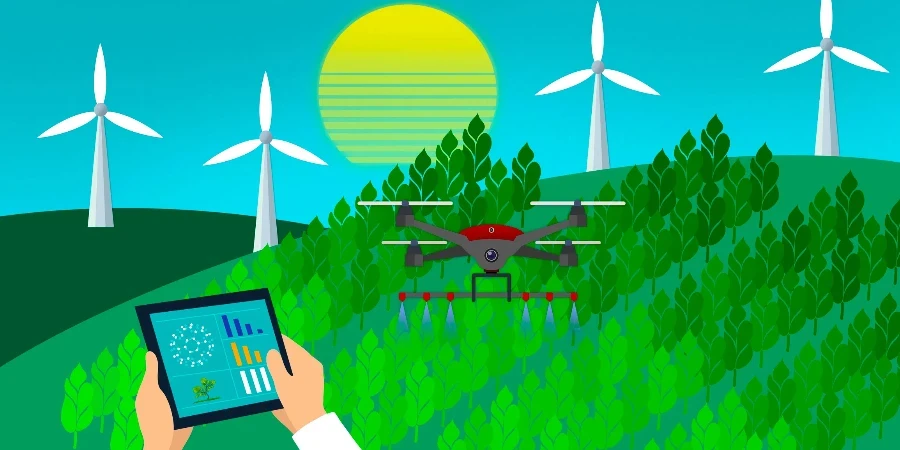شهد سوق رش الطائرات بدون طيار للزراعة تطورات سريعة في عام 2025، مدفوعًا بالحاجة إلى الدقة والاستدامة. تقدم هذه المقالة تحليلًا متعمقًا لأحدث التقنيات ومقاييس الأداء والاعتبارات التنظيمية، مما يوفر رؤى قيمة للمشترين المحترفين الذين يتطلعون إلى الاستثمار في أنظمة رش الطائرات بدون طيار المتطورة.
جدول المحتويات:
-استكشاف سوق رش الطائرات بدون طيار للزراعة في عام 2025 وما بعده
-العوامل الرئيسية عند اختيار حلول رش الطائرات بدون طيار للزراعة
- ضمان الامتثال التنظيمي
-معايير السلامة والشهادات
- المتانة وجودة البناء
- الاستعداد للمستقبل وإمكانية الترقية
-تقييم عمر المنتج وقيمة إعادة البيع
- تعقيد التعبئة والإعداد الأولي
- كفاءة الطاقة والاعتبارات البيئية
-الأفكار النهائية
استكشاف سوق رش الطائرات بدون طيار للزراعة في عام 2025 وما بعده
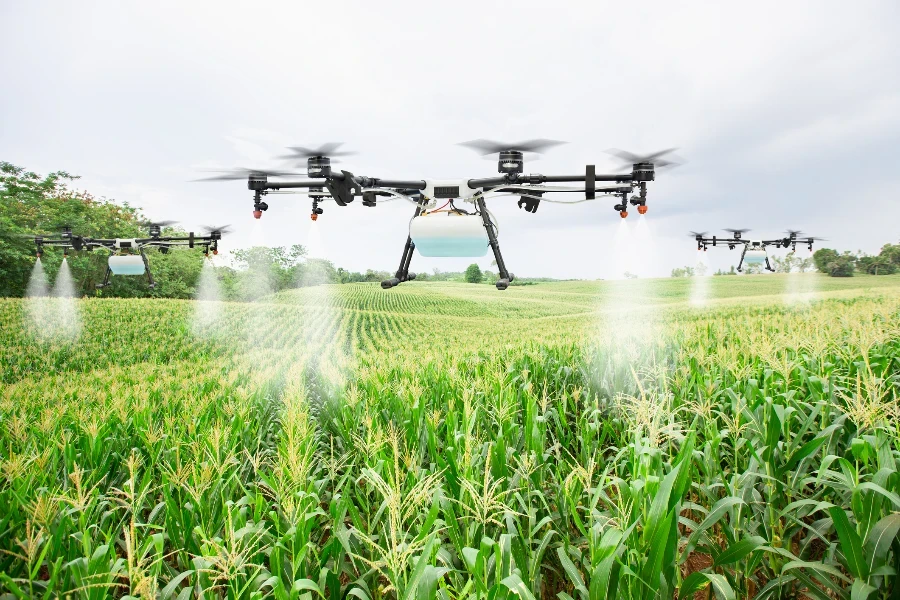
نظرة عامة على السوق: رش الطائرات بدون طيار للزراعة
يشهد سوق رش الطائرات بدون طيار للزراعة نموًا كبيرًا بسبب الحاجة المتزايدة إلى الزراعة الدقيقة وممارسات الزراعة المستدامة. اعتبارًا من عام 2024، بلغت قيمة السوق 1.89 مليار دولار أمريكي ومن المتوقع أن تصل إلى 7.2 مليار دولار أمريكي بحلول عام 2030، بمعدل نمو سنوي مركب (CAGR) بنسبة 25.2٪. ويعود هذا النمو إلى التطورات في تكنولوجيا الطائرات بدون طيار وارتفاع تكاليف العمالة والدفع العالمي نحو أساليب الزراعة الفعالة والصديقة للبيئة.
تنقسم السوق إلى تطبيقات مختلفة، بما في ذلك مكافحة الآفات ومراقبة المحاصيل وإدارة الري. ويتراوح المستخدمون النهائيون من الشركات الزراعية واسعة النطاق إلى المزارع والمزارع الصغيرة. ويبرز اعتماد تقنية الرش بالطائرات بدون طيار في المناطق ذات البنية التحتية الزراعية المتقدمة، مثل أمريكا الشمالية وأوروبا، ويكتسب زخمًا في الأسواق الناشئة في منطقة آسيا والمحيط الهادئ وأمريكا اللاتينية.
هناك العديد من العوامل التي تدفع السوق إلى التوسع، بما في ذلك الحوافز الحكومية التي تشجع على استخدام أجهزة الرش بالطائرات بدون طيار، ودمج الزراعة الذكية وتطبيقات إنترنت الأشياء، وزيادة الوعي بفوائد الرش بالطائرات بدون طيار مقارنة بالطرق التقليدية. ومع ذلك، لا تزال هناك تحديات مثل العقبات التنظيمية، وتكاليف الاستثمار الأولية المرتفعة، ومتطلبات المهارات الفنية اللازمة لتشغيل هذه الأنظمة.
تحليل متعمق لسوق رش الطائرات بدون طيار للزراعة
تتميز سوق رش الطائرات بدون طيار للزراعة بالتقدم التكنولوجي والاستراتيجيات التنافسية. تشمل معايير الأداء الرئيسية تطوير نماذج طائرات بدون طيار فعالة من حيث التكلفة وسهلة الاستخدام، وتحسين عمر البطارية وسعة الحمولة، ودمج الذكاء الاصطناعي وتحليلات البيانات لتحسين مراقبة صحة المحاصيل. يواصل اللاعبون الرائدون في السوق مثل DJI وPrecisionHawk وYamaha Motor Corporation الابتكار باستمرار للحفاظ على حصتهم في السوق وتلبية الاحتياجات المتطورة للمزارعين المعاصرين.
إن التأثيرات الاقتصادية مثل ارتفاع تكاليف العمالة والطلب على زيادة إنتاج المحاصيل تدفع المزارعين نحو تبني تقنيات الرش بالطائرات بدون طيار. كما يتغير سلوك المستهلك، مع تفضيل ممارسات الزراعة العضوية وتقنيات الزراعة الذكية التي تقلل من استخدام المواد الكيميائية والتأثير البيئي. كما تتنوع قنوات التوزيع، مع التركيز على منصات المبيعات عبر الإنترنت ونماذج البيع المباشر للمستهلك، مما يتيح سهولة الوصول إلى أحدث تقنيات الطائرات بدون طيار.
وتشمل الابتكارات الحديثة طائرات بدون طيار متعددة الوظائف قادرة على أداء مهام زراعية مختلفة، من رش المبيدات الحشرية إلى مراقبة صحة المحاصيل في الوقت الفعلي. إن دورة حياة منتج أجهزة الرش بدون طيار قصيرة نسبيًا، مع التقدم التكنولوجي السريع الذي يؤدي إلى التحديثات المتكررة وإصدارات النماذج الجديدة. والرقمنة أمر بالغ الأهمية، مع حلول برمجية متقدمة تمكن من رسم الخرائط الدقيقة والتخطيط الآلي للطيران وتحليل البيانات في الوقت الفعلي.
معالجة التحديات واغتنام الفرص في سوق رش الطائرات بدون طيار للزراعة
وعلى الرغم من آفاق النمو الواعدة، تواجه سوق رش الطائرات بدون طيار للزراعة العديد من التحديات التي تحتاج إلى معالجتها من أجل التوسع المستدام. وتظل العقبات التنظيمية تشكل عائقًا كبيرًا، حيث تؤثر اللوائح المختلفة عبر المناطق المختلفة على معدل تبني تقنيات الطائرات بدون طيار. كما تشكل تكاليف الاستثمار الأولية المرتفعة والحاجة إلى الخبرة الفنية تحديات أيضًا، وخاصة بالنسبة للمزارعين الصغار في المناطق النامية.
وللتغلب على هذه التحديات، يركز اللاعبون في الصناعة على تطوير تقنيات طائرات بدون طيار أكثر فعالية من حيث التكلفة وقوة مع عمر بطارية أطول ومقاومة أفضل للطقس. ويمكن أن يساعد الاستثمار في برامج التدريب لمشغلي المزارع في التخفيف من حواجز المهارات وتعزيز تبني تقنيات الرش بالطائرات بدون طيار على نطاق أوسع. بالإضافة إلى ذلك، يمكن للتعاون الاستراتيجي مع شركات التكنولوجيا ومؤسسات البحث أن يحفز الابتكار في تقنيات الاستشعار، وجمع البيانات في الوقت الفعلي، وقدرات المعالجة.
يقدم السوق العديد من الفرص للنمو، وخاصة في دمج الذكاء الاصطناعي والتعلم الآلي للتحليلات التنبؤية والعمليات المستقلة. يوفر استخدام الطائرات بدون طيار التي تدعم إنترنت الأشياء لإدارة الأسطول والأتمتة إمكانية لتحقيق مكاسب كبيرة في الكفاءة. يمكن للابتكارات في استقلالية الطائرات بدون طيار وتكنولوجيا البطاريات أن تعزز بشكل أكبر القدرات التشغيلية لرشات الطائرات بدون طيار، مما يجعلها أكثر قابلية للتطبيق للعمليات الزراعية واسعة النطاق.
العوامل الرئيسية عند اختيار حلول رش الطائرات بدون طيار للزراعة
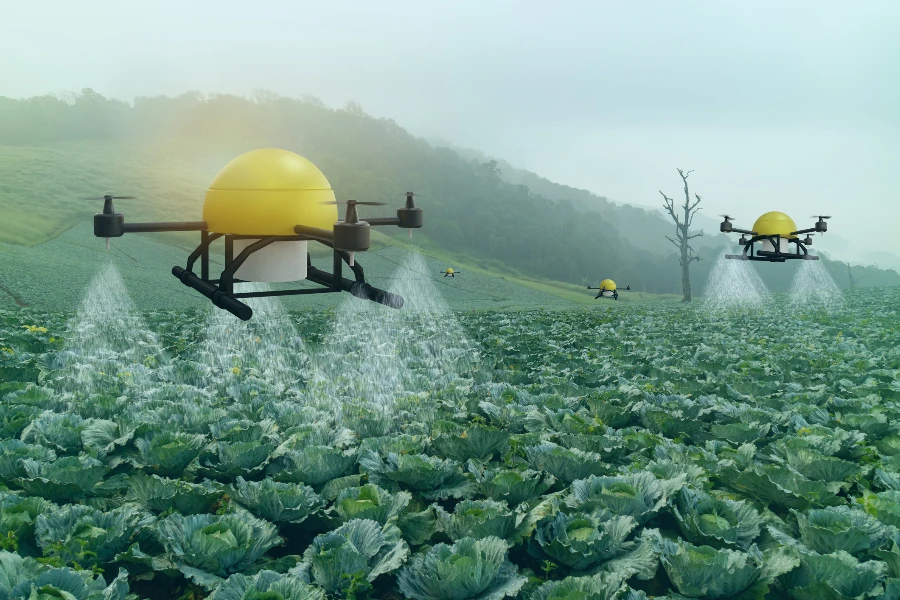
أنواع أنظمة رش الطائرات بدون طيار الزراعية
يتم تصنيف أنظمة رش الطائرات بدون طيار الزراعية على أساس آليات الدفع وقدرات الحمولة. تحظى الطائرات بدون طيار متعددة الدوارات بشعبية كبيرة بسبب استقرارها ودقتها، مما يجعلها مثالية للحقول الصغيرة والمتوسطة. تناسب الطائرات بدون طيار ذات الأجنحة الثابتة العمليات واسعة النطاق، حيث تغطي مناطق واسعة بسرعة ولكنها تحتاج إلى مساحة أكبر للإقلاع والهبوط.
تجمع الطائرات بدون طيار الهجينة بين ميزات الدوارات المتعددة والأجنحة الثابتة، مما يوفر إقلاعًا عموديًا ورحلة أفقية فعالة، ومناسبة للتضاريس المتنوعة والحقول ذات الأحجام المختلفة. يعتمد اختيار الطائرة بدون طيار على الاحتياجات الزراعية المحددة وظروف الحقل.
الأداء والوظيفة
تتضمن مقاييس الأداء الرئيسية لأنظمة رش الطائرات بدون طيار الزراعية نطاق الرش والكفاءة والتحكم في حجم القطرات. تضمن النماذج المتقدمة ذات الفوهات عالية الدقة توزيع المبيدات الحشرية أو الأسمدة بشكل موحد، مما يقلل من الهدر والتأثير البيئي. يعد التحكم في حجم القطرات أمرًا ضروريًا: حيث تغطي القطرات الأصغر مساحات كبيرة بكفاءة، في حين أن القطرات الأكبر حجمًا أفضل للتطبيقات المستهدفة.
تتضمن الوظيفة الملاحة المستقلة باستخدام نظام تحديد المواقع العالمي (GPS) وأجهزة استشعار أخرى. يمكن للطائرات بدون طيار الحديثة المزودة بأنظمة تحكم طيران متطورة اتباع مسارات مبرمجة مسبقًا وتجنب العوائق، مما يضمن أنماط رش متسقة ويقلل من التدخل اليدوي، وبالتالي زيادة الكفاءة والسلامة.
بيانات المعدة
عند تقييم أنظمة رش الطائرات بدون طيار الزراعية، ضع في اعتبارك سعة الحمولة، والتي تتراوح من بضعة لترات إلى أكثر من 30 لترًا، لتحديد كمية المبيدات الحشرية أو الأسمدة التي يمكن للطائرة بدون طيار حملها في كل رحلة. يتراوح وقت الرحلة، المتأثر بسعة البطارية ووزن الحمولة، عادةً بين 20 إلى 60 دقيقة. يمكن للطائرات بدون طيار ذات البطاريات القابلة للتبديل أن تمدد وقت التشغيل بشكل كبير.
كما أن عرض الرش ومعدل التدفق مهمان أيضًا. حيث يتيح عرض الرش الأوسع تغطية أسرع، ويضمن معدل التدفق القابل للتعديل تطبيق الكمية الصحيحة من المادة بناءً على احتياجات المحصول. كما تؤثر جودة بناء الطائرة بدون طيار، بما في ذلك المواد المستخدمة، على متانتها ومقاومتها للبيئات الزراعية القاسية.
أحدث ميزات التكنولوجيا
تتضمن التطورات الحديثة في تكنولوجيا رش الطائرات بدون طيار في المجال الزراعي التحليلات القائمة على الذكاء الاصطناعي وتكامل إنترنت الأشياء. تعمل خوارزميات الذكاء الاصطناعي على تحليل صحة المحاصيل وتحسين أنماط الرش في الوقت الفعلي. تتواصل الطائرات بدون طيار المدعومة بإنترنت الأشياء مع المعدات الزراعية الأخرى، مما يوفر بيانات شاملة لاتخاذ قرارات أفضل.
تكتشف الطائرات بدون طيار المزودة بكاميرات متعددة الأطياف وفائقة الطيف إجهاد المحاصيل ونقص العناصر الغذائية غير المرئي بالعين المجردة، مما يسمح بالتدخلات المستهدفة. يضمن تكامل تقنية Blockchain إمكانية التتبع والشفافية في عمليات التطبيق، وهو ما يزداد الطلب عليه من قبل الهيئات التنظيمية والمستهلكين.
النطاق السعري واعتبارات الميزانية
تختلف تكلفة أنظمة رش الطائرات بدون طيار الزراعية وفقًا للقدرات والميزات. تتراوح أسعار النماذج الأولية للمزارع الصغيرة من 2,000 دولار إلى 5,000 دولار، بينما تتراوح أسعار الأنظمة المتقدمة ذات سعة الحمولة العالية والتكنولوجيا المتطورة من 10,000 دولار إلى أكثر من 50,000 دولار. ضع في اعتبارك التكلفة الإجمالية للملكية، بما في ذلك الصيانة واستبدال البطاريات واشتراكات البرامج.
إن خيارات التأجير والإعانات الحكومية من الممكن أن تجعل النماذج الراقية في متناول المشترين الذين يهتمون بالميزانية. إن تقييم العائد على الاستثمار أمر بالغ الأهمية؛ فعوامل مثل زيادة غلة المحاصيل، وخفض تكاليف العمالة، وانخفاض استخدام المبيدات الحشرية من الممكن أن تبرر الإنفاق الأولي. وتقدم بعض الشركات المصنعة تصميمات معيارية للترقيات المستقبلية، مما يضمن بقاء النظام ذا صلة مع تطور التكنولوجيا.
ضمان الامتثال التنظيمي
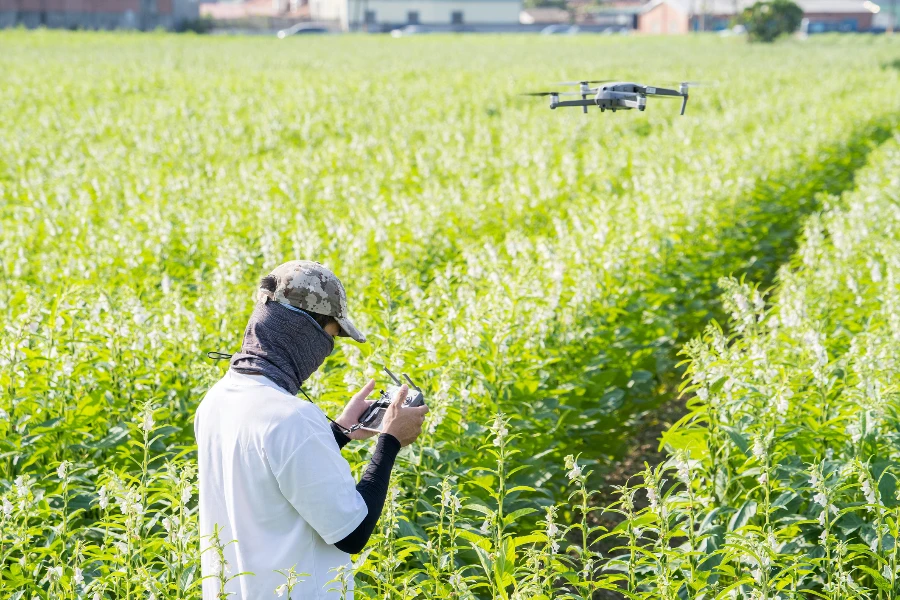
يعد الامتثال للمعايير التنظيمية أمرًا بالغ الأهمية عند استخدام أنظمة رش الطائرات بدون طيار الزراعية. تختلف اللوائح حسب البلد والمنطقة، وتغطي شهادات الطيارين، وتصاريح الطيران، وإرشادات تطبيق المبيدات الحشرية. إن البقاء على اطلاع باللوائح المحلية يتجنب المشكلات القانونية ويضمن عمليات آمنة.
في الولايات المتحدة، تلزم إدارة الطيران الفيدرالية (FAA) مشغلي الطائرات بدون طيار التجارية بالحصول على شهادة الجزء 107. كما وضعت وكالة حماية البيئة (EPA) إرشادات محددة لتطبيق المبيدات الحشرية باستخدام الطائرات بدون طيار. ويضمن الالتزام بهذه اللوائح الامتثال القانوني ويعزز ممارسات الزراعة المسؤولة والمستدامة.
معايير وشهادات السلامة
السلامة أمر بالغ الأهمية في عمليات الطائرات بدون طيار في الزراعة. يجب أن تلتزم الطائرات بدون طيار بمعايير السلامة الصارمة لمنع الحوادث وضمان سلامة المشغلين والمارة. تشمل الشهادات الرئيسية ISO 21384-3:2019 لأنظمة الطائرات بدون طيار (UAS) وASTM F3196-17 لأنظمة الطائرات بدون طيار الصغيرة.
يقوم المصنعون بإجراء اختبارات مكثفة لضمان قدرة الطائرات بدون طيار على تحمل البيئات الزراعية القاسية، بما في ذلك التعرض للمواد الكيميائية وظروف الطقس القاسية. تعمل الميزات مثل آليات الأمان ضد الأعطال، ووظائف العودة إلى المنزل، والأنظمة الاحتياطية على تعزيز السلامة التشغيلية. تعمل الصيانة والتفتيش المنتظمان على إبقاء الطائرات بدون طيار في حالة عمل مثالية.
المتانة وجودة البناء
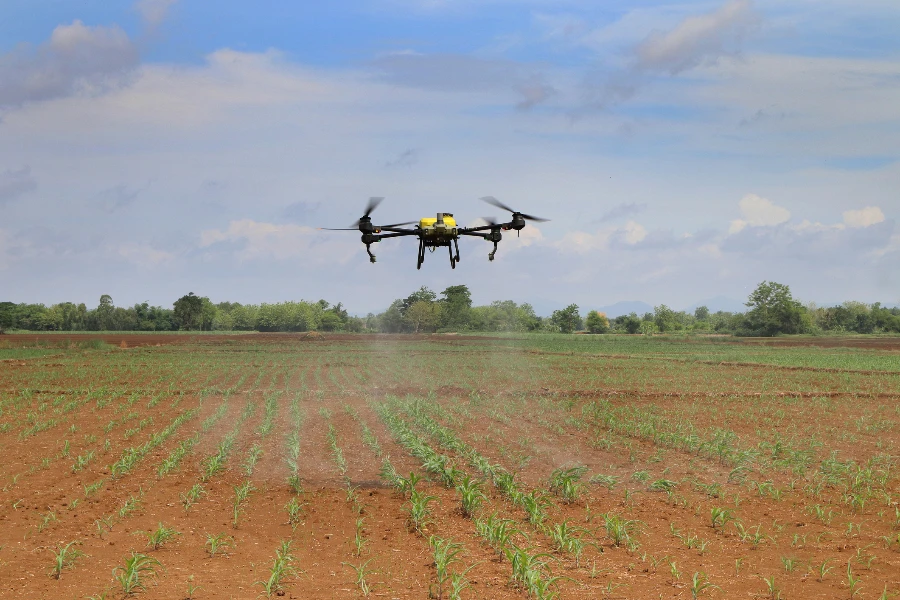
تعتبر المتانة أمرًا مهمًا بالنسبة للطائرات بدون طيار المخصصة للزراعة نظرًا لأنها تعمل في بيئات صعبة. حيث تعمل المواد عالية الجودة مثل ألياف الكربون والألومنيوم المستخدم في صناعة الطائرات على بناء إطارات قوية تتحمل الصدمات والاهتزازات. كما تعمل التصميمات المقاومة للماء والغبار على تعزيز المتانة، مما يضمن أداءً موثوقًا به في مختلف الظروف الجوية.
تسمح التصميمات المعيارية باستبدال المكونات التالفة بسهولة، مما يقلل من وقت التوقف عن العمل وتكاليف الصيانة. تقدم الشركات المصنعة ضمانات ودعم ما بعد البيع لحل المشكلات بسرعة. يضمن الاستثمار في الطائرات بدون طيار المتينة الموثوقية على المدى الطويل ويقلل من التكلفة الإجمالية للملكية.
الاستعداد للمستقبل وإمكانية الترقية
يعد الاستعداد للمستقبل أمرًا بالغ الأهمية في مجال تكنولوجيا الطائرات بدون طيار الزراعية المتطور. يتيح اختيار الطائرات بدون طيار ذات المكونات المعيارية والقابلة للترقية دمج التقنيات الجديدة فور توفرها. ويشمل ذلك التطورات في أجهزة الاستشعار وخوارزميات الذكاء الاصطناعي وتكنولوجيا البطاريات، مما يعزز القدرات ويطيل عمر البطارية.
يعد التوافق مع أنظمة إدارة المزارع الحالية وأجهزة إنترنت الأشياء أمرًا مهمًا للتكامل السلس. توفر الطائرات بدون طيار التي تدعم البرامج مفتوحة المصدر وبروتوكولات الاتصال الموحدة مرونة وقابلية للتكيف أفضل. إن مراعاة إمكانات الترقية تضمن أن يظل الاستثمار ذا صلة ويستمر في تقديم القيمة على المدى الطويل.
تقييم عمر المنتج وقيمة إعادة البيع
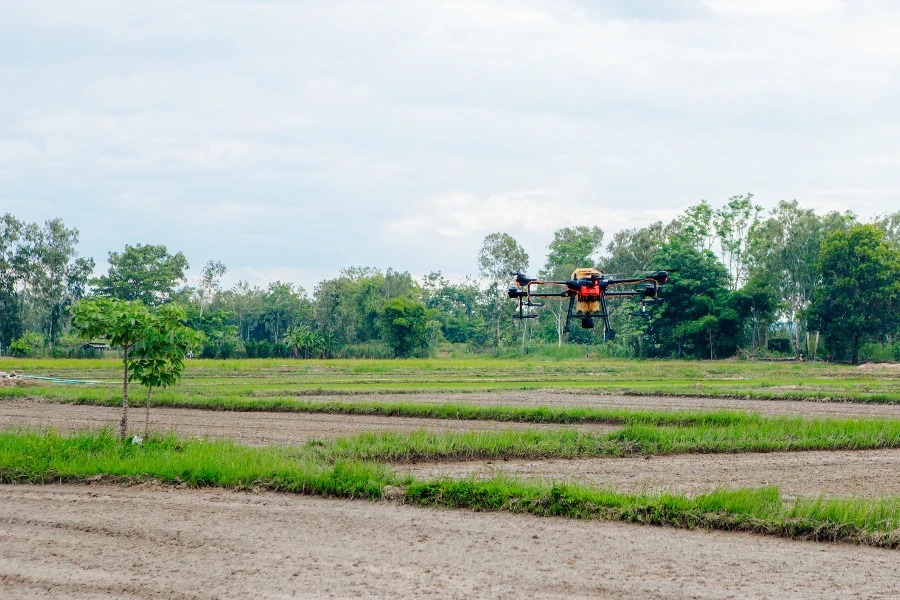
تعتمد مدة عمر الطائرات بدون طيار الزراعية على جودة التصنيع وممارسات الصيانة وكثافة الاستخدام. يمكن للطائرات بدون طيار عالية الجودة أن تدوم لعدة سنوات مع العناية المناسبة، في حين قد تحتاج النماذج الأقل تكلفة إلى استبدالات أكثر تكرارًا. يمكن لتحديثات البرامج وخدمات الصيانة المنتظمة إطالة العمر التشغيلي.
تعد قيمة إعادة البيع من الاعتبارات الأخرى للشركات التي تقوم بتحديث المعدات بشكل دوري. تحتفظ الطائرات بدون طيار التي يتم صيانتها جيدًا من العلامات التجارية المشهورة بقيمتها بشكل أفضل في السوق الثانوية. إن توثيق سجلات الصيانة والتأكد من أن الطائرة بدون طيار في حالة عمل جيدة يعزز من إمكانية إعادة بيعها، مما يوفر فوائد مالية إضافية.
تعقيد التعبئة والإعداد الأولي
تعتبر جودة التغليف وتعقيد الإعداد الأولي أمرًا مهمًا للتجربة الشاملة للمستخدم. تسهل الطائرات بدون طيار ذات التغليف الشامل، بما في ذلك العلب الواقية وأدلة التعليمات التفصيلية، النقل الآمن والإعداد السهل. تعمل الملصقات الواضحة والمكونات المنظمة على تقليل مخاطر التلف أثناء الشحن والمناولة.
تختلف تعقيدات الإعداد الأولي وفقًا لتصميم الطائرة بدون طيار وميزاتها. تعمل الواجهات سهلة الاستخدام والبرامج البديهية والبرامج التعليمية التفصيلية على تقليل منحنى التعلم بشكل كبير. تقدم بعض الشركات المصنعة خدمات التدريب والدعم في الموقع للمساعدة في الإعداد الأولي وضمان إتقان المشغلين لاستخدام الطائرة بدون طيار بشكل فعال.
كفاءة الطاقة والاعتبارات البيئية
إن كفاءة الطاقة تشكل أهمية بالغة في الزراعة، ولا تشكل أنظمة الرش بالطائرات بدون طيار استثناءً. فالطائرات بدون طيار ذات الديناميكية الهوائية المحسنة وأنظمة إدارة الطاقة الفعّالة تستهلك قدرًا أقل من الطاقة، مما يقلل من تكاليف التشغيل والتأثير البيئي. كما توفر التطورات في تكنولوجيا البطاريات، مثل بطاريات الليثيوم والكبريت والبطاريات الصلبة، كثافات طاقة أعلى وأوقات طيران أطول.
وتمتد الاعتبارات البيئية إلى المواد التي يتم رشها. وتعمل تقنيات الرش الدقيقة على تقليل استخدام المبيدات الحشرية والأسمدة، مما يقلل من جريان المياه وتلوث مصادر المياه. وقد تم تصميم بعض الطائرات بدون طيار للعمل مع المنتجات العضوية والصديقة للبيئة، مما يدعم ممارسات الزراعة المستدامة. ومن خلال إعطاء الأولوية لكفاءة الطاقة والمسؤولية البيئية، تساهم أنظمة الرش بالطائرات بدون طيار في الزراعة في مستقبل أكثر استدامة.
افكار اخيرة
تستمر صناعة رش الطائرات بدون طيار في الزراعة في التطور، مدفوعة بالتقدم التكنولوجي والطلب المتزايد على حلول الزراعة الفعالة والمستدامة. عند اختيار نظام رش الطائرات بدون طيار، ضع في اعتبارك عوامل مثل الأداء والوظائف والمواصفات الفنية والامتثال التنظيمي. إن الاستثمار في الطائرات بدون طيار عالية الجودة والمتينة والمستقبلية يعزز الممارسات الزراعية ويحسن غلة المحاصيل ويساهم في مستقبل أكثر استدامة.
